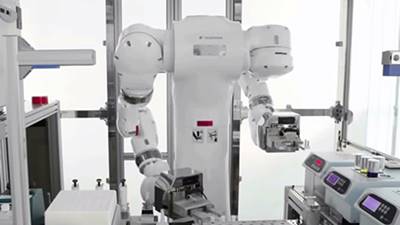There are unique challenges to accelerating ramp-up and meeting business objectives for pharmaceutical projects that can cause substantial delays and blow-outs. But it doesn’t have to be this way. In fact, challenges can become unique opportunities for achieving operational excellence.
When planning a ramp-up of pharmaceutical production, many projects face substantial delays and have lower than expected productivity. Unfortunately, this means missing out on significant business opportunities in an increasingly competitive market. In our experience, one central reason projects struggle to meet operational targets is a lack of focus in the very early project phases on developing the future operating model.

An effective and future-proof operating model is key in pharma manufacturing facility projects
An operating model describes how a future facility will operate across process, organization, and technology to deliver value. It is likely new products will be introduced frequently once the facility is running, so a robust operating model that allows for efficient change-over and fast ramp-up of new products is vital.
However, a common issue when ramping up production in pharmaceutical manufacturing is a misalignment between the incentives of the engineering team and operations. There is often a bias towards meeting targets for construction, process design, equipment selection, purchase and installation, while the effort to build an effective and future-proof operating model is ignored or down-prioritized with the notion that “we are too busy to look into that right now”.
In addition, resources for addressing operational issues can be limited when designing the facility, and operations staff rarely have experience designing future operations in a structured way. Their competencies lie in running existing operations – not designing new ones.
Due to this lack of resources, project managers and operations managers struggle to fill the gaps in the operating model in the later stages of a pharma facility project. This means suboptimal solutions and a stressful working environment for teams already struggling with fatigue.
Reach operational readiness in pharma manufacturing facility projects
Luckily, there are several initiatives that can mitigate this. First, leaders should invest their efforts in both the investment project and how to run future operations by creating plans from the start for both engineering activities and for preparing operations. It is then important that these plans are continuously aligned.

Second, it needs to be very clear what “execution-ready” means and the exact steps needed to achieve this readiness. You must define precisely what you mean by “ready” and which stakeholders have assigned accountability for certain criteria or tasks. Leaders must embed a change of mindset to ensure that named members of the operations team take ownership of operational readiness by defining their role as “accelerating readiness for operation” rather than “waiting for everything to be ready so they can sign off”.
In our experience, it can seem throughout the project that the operations team has a plan and an overview of remaining activities to prepare for operations. However, in reality the plans are often initiated too late, are outdated, and are seldom aligned with other stakeholders.
How to prepare for operational readiness to ensure fast ramp-up and sustainable operational excellence?
To ensure fast ramp-up and operational excellence during a project, the focus should be on technological and operational readiness.

To reach technological readiness, the pharmaceutical company's operations team and the engineering provider must build a strong link between the process and facility design. To achieve operational readiness, you need to build a robust operating model throughout the project phase.

It is a considerable challenge to develop the organizational and operational set-up and simultaneously guide the engineering project. Important things to consider include:
- Clarifying the impact different design options have on operations, e.g. manning, competencies, flexibility, room for expansion, compliance with cGMP trends, maintenance
- Incorporating your plans and visions for improving future operations into requirements and solutions, e.g. batch release/review by exception, paperless documentation and augmented reality
- The availability of competent and motivated user resources, which typically becomes a bottleneck
However, creating a new organization and defining how it will operate is a major opportunity for implementing new and better ways of working, such as:
- New, more efficient procedures, methods and systems
- Simplifying procedures and job instructions
- Preparing the on-boarding of operators and supporters well
- Clarifying early-on of the impact of different design options on operations
- Integrating plans and visions for improving future operations into technical requirements and solutions
Overall, preparing for operational excellence means continuously aligning process design, facility design and operating model design throughout the entire project. This is key to ensure the design is optimal and cost-effective.
A structured approach to preparing an operating model
When preparing an operating model, it is important that management initially drives development. Then, when more specific elements are ready, it can gradually be taken over by employees. The approach can be adapted for any size of project - from greenfield to smaller re-building projects. Below are two best practice examples:

Case 1 - A fully aligned organization for seamless ramp-up
In connection with a major expansion of existing capacity with a large greenfield API plant at a new location, the preparation of the operating model was initiated during the early phases of the basic design. A site aspiration regarding operational readiness was defined and aligned across the full senior management team including both engineering and operations. Basic operating principles and new ways of working were agreed upon in the leadership team and specific implications for the new site were described.
A roadmap was created to clarify the activities required to build a future-proof operating model and the coherence between the elements in the model was defined. For each element (business processes, SOPs, training, recruitment, etc.) unique responsibilities were defined and detailed plans were prepared. The plans ensured continuous alignment of preparation of operations with the engineering plans. Overall, business processes and manufacturing processes were described and communicated in a clear manner to the organization to ensure process understanding, and to make sure they understood which operating principles should guide future operations. New ways of thinking, process-oriented SOPs and training principles were introduced and developed during the project. The result is an organization that is fully aligned with all elements of the operating model prepared in due time to ensure seamless ramp-up.
Case 2 - A road-map of activities to close gaps and align milestones
A mid-size fill-finish project was close to ramping-up an existing site with known processes. An assessment was made to clarify current readiness for operations. Findings and gaps were condensed and aligned in the management team. They then made an overall road map of activities required to close the gaps and aligned milestones with engineering and product transfer milestones. Detailed plans were created for each element in the operating model (SOPs, training, recruitment, etc.) and unique responsibilities were assigned. The result was full transparency and coherence of plans, creating confidence in their ability to meet overall business objectives.
To conclude, a good operating model must address all elements be continuously aligned from a conceptual to a specific level. Examples of deliverables include:
- Aspiration/objectives
- Operating principles
- Manufacturing/business processes
- Organizational, roles and responsibilities
- Standard Operating Procedures (SOP) development plan/program
- Competence/capacity requirements
- On-boarding/training program
- Quality system setup
- IT system alignment
- Communication strategy and plan


